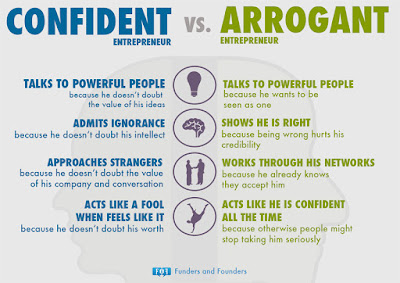 |
| Image credit; Funders and Founders |
One of the biggest challenges we face as designers is how to assemble and participate on effective teams. This is particularly true when interviewing someone for a job opening or looking to bring someone new onto an existing team.
One of the most important skills is being able to distinguish between confidence and arrogance because both project a "capable" image and you want someone who is capable of seeing what needs to be done and getting it done. Here are five things to consider when building teams or reflecting on your own effectiveness. Each behavior is an indicator of whether the person you are considering is confident and capable or an arrogant poser.
One of the most important skills is being able to distinguish between confidence and arrogance because both project a "capable" image and you want someone who is capable of seeing what needs to be done and getting it done. Here are five things to consider when building teams or reflecting on your own effectiveness. Each behavior is an indicator of whether the person you are considering is confident and capable or an arrogant poser.
1. Condescending remarks
Confident people feel good about themselves without desiring to judge or offend others. They usually optimistic, seeing the good in others, their potential, and want to help others succeed. They will talk about their own achievements in the context of the successes of their teams. Note this is at odds with the competitive attitude often espoused and cherished by those who value short term success over long term sustainability.
The primary attitude which an arrogant person manifests is superiority. They are very concerned with figuring out where in the pecking order they are and judging their relative strengths compared to others. This may be a tell-tale indication that they have deep feelings of inferiority and insecurity, particularly when interacting with someone who may be more capable, better educated or more successful than they are. One consequence of this is that arrogant people try to improve their own status by tearing others down.
2. Self-perception
Confident people typically feel comfortable with themselves because they have an accurate self image. They are aware of their weaknesses and know how to deal with them. Arrogant people diminish their own shortcomings and struggle to admit their own mistakes.
3. Relationships
Relationships with arrogant people can be very stressful. The proud and arrogant live in a world of self-importance where nothing affects them and they typically dismiss or ignore corrective feedback.
A self-confident person is able to show vulnerability and admit their past mistakes. This quality is highly appreciated by others. Arrogant people fear failure and loss of control and will sacrifice friendships and relationships if they think it will improve their own chances of success.
4. Communication Style, Eye Contact and Conversational Flow
Confident people rarely lecture, preach or point out how others are wrong. They typically show respect while listening. Arrogant people have difficulty listening and love to be in the spotlight. They are often critical and blame others if things don't go as planned.
Communication with arrogant people is challenging. An arrogant person will always try to one-up everything you say. They only care about their own position and making others accept their ideas. That’s why people try to avoid conversations with them; it’s difficult having a productive, two way conversation with someone who is never wrong. Confident people don’t try to impose their vision of the situation on others. They enjoy collaboration and the increased accomplishments of their teams speak for themselves.
Eye contact is part of any conversation. Confident people will make appropriate eye contact with you and make you feel as though you are the most important person in the room. Arrogant people will be looking past you for someone else to talk to, or act like they have something better to do, because they think another person will benefit them more than talking with you. It is difficult to catch and hold the eye or ear of an arrogant person. Note that there are deep cultural differences between western and eastern cultures on this point which you must take into account.
5. Root Causes
Arrogance and confidence have different origins. Arrogance is usually the result of an unconscious defense mechanism to prevent criticism. Confidence comes with patience, optimism and experience.
The deep issue with arrogance is the fear of being inferior blinds people to the value and power of collaboration and relationships. Unfortunately, the arrogance-fear cycle is self perpetuating as the arrogant person drives away the people who's help they need to succeed beyond their own personal limitations.

